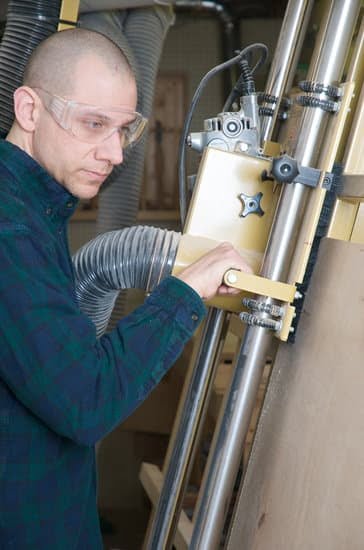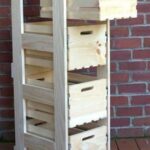Cracks along the woodwork on a ceiling can be a frustrating and unsightly problem for homeowners. These cracks not only compromise the aesthetic appeal of the space, but they also raise concerns about the structural integrity of the ceiling. Understanding the causes behind these cracks is crucial in order to effectively address and prevent them.
In this comprehensive guide, we will delve into the various factors that contribute to the formation of cracks along woodwork on ceilings. From improper installation techniques to moisture and humidity, we will explore both common and lesser-known culprits that can lead to crack formation.
One important factor to consider is the impact of temperature fluctuations on woodwork. As wood naturally expands and contracts with changes in temperature and humidity levels, it can create stress within the material, eventually resulting in cracks. Additionally, aging wood and its susceptibility to cracking will be examined, shedding light on how time can exacerbate this issue.
External factors including environmental conditions and external stressors such as heavy furniture or objects placed above the ceiling should also be taken into account when examining crack formation. Neglecting proper maintenance routines can further worsen existing cracks or even cause new ones to form.
By understanding these causes, homeowners can take preventive measures to avoid and minimize cracks along woodwork on their ceiling. Additionally, a step-by-step guide will be provided for those looking to repair and restore cracked woodwork, offering solutions for those who are already dealing with this issue.
Identifying the Different Types of Cracks
Cracks along woodwork on the ceiling can be a frustrating and unsightly problem for homeowners. Understanding the different types of cracks that can occur is essential in determining the underlying cause and finding an appropriate solution. This comprehensive guide will help you identify various types of cracks and their possible causes.
Hairline cracks
Hairline cracks are shallow and thin, often barely visible to the naked eye. They are commonly caused by natural shrinkage or settling of wood due to changes in humidity and temperature. These cracks are typically not a cause for concern unless they become wider or longer over time.
Surface cracks
Surface cracks refer to cracks that appear on the surface of the woodwork but do not penetrate through it. These cracks may occur due to minor impacts or heavy loads on the ceiling, causing stress on the woodwork.
Longitudinal cracks
Longitudinal cracks run parallel to the length of the woodwork, usually indicating a structural issue such as weak foundations or supports. These cracks can be more serious and require immediate attention as they may compromise the integrity of the entire structure.
Diagonal or intersecting cracks
Diagonal or intersecting cracks form at an angle across the woodwork and can be caused by movement or shifting in the building’s structure. These types of cracks may indicate foundation problems, inadequate framing, or excessive load-bearing pressure.
Splitting or splitting along grain
Splitting occurs when a crack cuts through the entire thickness of the wood, usually following its natural grain lines. It can happen due to excessive moisture exposure, poor quality wood, or incorrect installation techniques.
By understanding these different types of cracks, homeowners can better assess their severity and determine whether professional intervention is necessary. It is important to note that cracks can have multiple causes and may require a combination of solutions to address them effectively. In the next sections of this article, we will explore some common causes of cracks along woodwork on the ceiling and provide tips on how to prevent and repair them.
Lack of Proper Installation
Cracks along woodwork on the ceiling can be caused by a variety of factors, one of which is a lack of proper installation techniques. When woodwork is not installed correctly, it can lead to structural issues that result in cracks over time.
One common problem with improper installation is inadequate support for the woodwork. When woodwork is not properly supported, it can sag or shift, creating stress points that eventually lead to cracks. Additionally, if nails or screws are not placed correctly or are too small for the job, they may not provide enough stability for the woodwork, causing it to become loose and susceptible to cracking.
Another issue that can arise from improper installation techniques is poor alignment. When wood pieces are not aligned properly during installation, it can create uneven stress distribution on the ceiling, leading to cracks along the woodwork. This misalignment can occur due to careless measurement or cutting errors.
Furthermore, using incorrect or inferior materials during installation can contribute to cracks in woodwork on the ceiling. Low-quality adhesive or caulking materials may not provide adequate strength and flexibility, causing them to fail over time and leading to cracking.
To prevent these problems and ensure proper installation of woodwork on the ceiling, it is crucial to hire professional contractors who are experienced in woodworking and have a good understanding of proper installation techniques. These professionals will know how to provide appropriate support for the wood pieces, align them accurately, and use high-quality materials that are suited for the job.
By addressing the issue of improper installation techniques when dealing with cracks along woodwork on ceilings, homeowners can take proactive steps towards preventing further damage and maintaining a structurally sound and aesthetically pleasing living space.
| Problem | Cause |
|---|---|
| Inadequate support | Sagging or shifting of woodwork due to lack of proper support |
| Poor alignment | Incorrectly aligning wood pieces causes uneven stress distribution |
| Low-quality materials | Inferior adhesive or caulking materials that fail over time |
Moisture and Humidity
Moisture and humidity are two common factors that often go unnoticed but can be significant culprits behind cracks in woodwork on the ceiling. When there is excessive moisture in the air or within the structure, it can cause the wood to expand and contract repeatedly. This constant movement puts stress on the woodwork, leading to cracks over time.
One of the primary sources of moisture in ceilings is from leaks or water infiltration. If there are any gaps, cracks, or damaged seals in the roofing system, rainwater can seep into the ceiling and cause the woodwork to absorb moisture. This can weaken the structural integrity of the wood and make it more susceptible to cracking.
Additionally, high humidity levels in a room can contribute to cracking in woodwork. When there is excess moisture in the air, it can penetrate into the wood and cause it to swell. As the wood swells and shrinks due to changes in humidity levels, it creates stress on the fibers of the wood. Over time, this stress can lead to cracks forming along the grain lines of the wood.
To prevent moisture-related cracks in woodwork on ceilings, it is essential to address any leaks or water infiltration issues promptly. Regularly inspecting your roof for any signs of damage or deterioration can help identify potential problems before they worsen. Additionally, maintaining proper ventilation within your home can help regulate humidity levels and minimize moisture buildup in the air.
Structural Issues
Introduction to Structural Issues
When it comes to cracks along woodwork on the ceiling, structural issues can often be a major underlying cause. These issues arise when there are weaknesses within the foundation or overall structural integrity of a building.
While they may not always be immediately apparent, the effects of these issues can manifest in the form of cracks along the woodwork on the ceiling. Understanding how weak foundations and structural instabilities contribute to these cracks is crucial in addressing and resolving the problem effectively.
Identifying Weak Foundations
One common structural issue that can lead to cracks along woodwork on the ceiling is a weak foundation. A weak foundation occurs when there is improper support for the weight and load of the structure above. This lack of adequate support puts additional stress on the structure, causing it to shift or settle unevenly over time. As a result, cracks can form along the woodwork as this shifting puts pressure on certain areas more than others.
To identify if weak foundations are contributing to the cracks, homeowners should look for other signs such as uneven floors, doors and windows that do not close properly, leaning walls, or visible gaps between walls and ceilings. If any of these indicators are present alongside the cracks in woodwork, it is essential to consult with a professional contractor or structural engineer to assess and address any underlying foundation issues.
Dealing with Structural Instabilities
Aside from weak foundations, structural instabilities also play a significant role in causing cracks along woodwork on the ceiling. These instabilities can arise from various factors such as poor construction techniques, shifting soil conditions, or natural events like earthquakes. When a structure lacks sufficient stability or experiences sudden movements or shifts, it can result in stress being placed on the woodwork, leading to cracks.
To mitigate these issues, it is important for homeowners to consult with professionals who specialize in addressing structural problems. Structural engineers can conduct thorough inspections, assess the stability of the building, and recommend appropriate repairs or reinforcements to prevent further damage and minimize the occurrence of cracks along woodwork on the ceiling.
By understanding how weak foundations and structural instabilities contribute to cracks in woodwork on the ceiling, homeowners can take proactive measures to address these issues effectively. Seeking professional guidance is crucial in identifying and resolving any underlying problems to ensure that the structure remains safe and secure.
Temperature Fluctuations
Temperature fluctuations can have a significant impact on the occurrence of cracks along woodwork on the ceiling. When the temperature rises, wood tends to expand, and when it cools down, it contracts. This continuous expansion and contraction can put stress on the wood, leading to cracks over time. Understanding how temperature fluctuations affect woodwork can help homeowners prevent and minimize these cracks.
Understanding Expansion and Contraction
When exposed to higher temperatures, the moisture in the wood evaporates, causing the cells within the wood to expand. As a result, the wood expands slightly in size. On the other hand, when temperatures drop, the moisture content increases, causing the cells to contract and reducing the overall size of the wood. These constant cycles of expansion and contraction can lead to stress build-up within the wood fibers, eventually resulting in cracks.
The Role of Poor Insulation
One common factor that exacerbates the impact of temperature fluctuations is poor insulation. Improperly insulated ceilings allow for more drastic changes in temperature between indoor and outdoor environments. Without adequate insulation, heat loss or gain from outside sources becomes more significant, causing more frequent and severe expansion and contraction cycles in wooden structures.
Preventing Temperature-Related Cracks
To prevent or minimize cracks caused by temperature fluctuations, there are several steps homeowners can take:
- Proper insulation: Ensuring that your ceiling is adequately insulated will help regulate indoor temperatures more effectively and reduce extreme differences compared to outdoor temperatures.
- Humidity control: Keep humidity levels inside your home stable by using dehumidifiers in humid climates or humidifiers in dry climates. Stable humidity levels can help minimize moisture content changes in wooden structures.
- Avoid direct exposure: Direct sunlight or heat sources near wooden ceilings should be minimized or blocked if possible. UV rays from sunlight can accelerate drying-out processes within wooden structures.
- Regular maintenance: Regularly inspect and maintain wooden ceilings, looking for signs of cracking or damage. Prompt repairs can prevent small cracks from worsening over time.
By taking these preventive measures, homeowners can effectively reduce the likelihood and severity of cracks caused by temperature fluctuations in woodwork on their ceiling. It is crucial to address these issues proactively to maintain the structural integrity and aesthetic appeal of the woodwork.
Age and Aging
As wood ages, it undergoes various changes in its physical properties that can make it more susceptible to cracks along woodwork on the ceiling. Understanding the role of aging wood is crucial in identifying and addressing the causes of cracks.
One factor that contributes to the susceptibility of aging wood to cracks is the loss of moisture content. Over time, wood naturally loses moisture, causing it to shrink. This shrinkage can create stress within the wood fibers, leading to the development of cracks. Additionally, as wood loses moisture, it also becomes more brittle, making it more prone to cracking under pressure or changes in temperature.
Another aspect of aging wood that affects its susceptibility to cracks is decay and deterioration. As wood ages, it becomes susceptible to rot, fungus, and insect infestation. These factors can weaken the structural integrity of the wood, making it more likely to crack under strain or pressure.
Moreover, as wood ages, it develops natural defects such as knots and splits. These defects create areas of weakness in the woodwork where cracks are more likely to form. The presence of these defects also reduces the overall strength and stability of the woodwork, increasing its vulnerability to cracking.
In summary, aging wood is more prone to developing cracks along woodwork on ceilings due to several factors including loss of moisture content, decay and deterioration, and natural defects. It is important for homeowners and builders alike to consider these factors when installing or maintaining wooden ceilings in order to prevent or minimize crack formation.
| Aging Factor | Susceptibility to Cracks |
|---|---|
| Loss of Moisture Content | Increases vulnerability due to shrinkage and brittleness. |
| Decay and Deterioration | Weakens structural integrity, making wood more likely to crack. |
| Natural Defects | Create areas of weakness where cracks are prone to form. |
External Factors
Cracks along woodwork on the ceiling can be caused by a variety of external factors, including environmental conditions and external stressors. Understanding how these factors contribute to crack formation is crucial in preventing and addressing the problem effectively.
One of the main external factors that influence crack formation in woodwork on the ceiling is fluctuating environmental conditions. Changes in temperature and humidity levels can cause wood to expand and contract, leading to cracks. For example, during hot and dry weather, wood tends to shrink, resulting in gaps and cracks along the woodwork. On the other hand, high levels of moisture or humidity can cause the wood to swell and eventually crack.
In addition to temperature and humidity, external stressors such as excessive weight or pressure can also contribute to crack formation in woodwork on the ceiling. Heavy objects placed on or hung from the ceiling can put strain on the woodwork, causing it to weaken over time. Similarly, vibrations from nearby construction work or even regular foot traffic above can create stress on the ceiling, leading to cracks.
| Environmental Factor | Impact on Crack Formation |
|---|---|
| Temperature Fluctuations | Expanding and contracting wood leads to cracks |
| Humidity Levels | High moisture content causes swelling and cracking |
| Weight/Pressure | Excessive weight strains woodwork leading to cracks |
| Vibrations/Stressors | External vibrations weaken woodwork and cause cracks |
By understanding the role of environmental conditions and external stressors in crack formation, homeowners can take preventive measures to minimize the risk. This may include maintaining optimal temperature and humidity levels in the home, ensuring proper weight distribution on the ceiling, and avoiding excessive vibrations or stressors.
Regular inspection and maintenance of woodwork on the ceiling can also help identify early signs of cracks and address them before they become more severe. Overall, being aware of these external factors is essential for maintaining a crack-free woodwork on the ceiling for years to come.
Sources:
- Duvall, John. “Understanding Homeowners’ concerns with Cracks in Wallboard Installed over Light-gage Steel Framing.” SSRN Electronic Journal, 2019.
- Hartemann, Paul E., et al. “Fungal Contamination in Public Buildings: A Guide to Recognition and Management.” Indoor Air Quality Handbook, edited by John D. Spengler et al., McGraw-Hill Education, 2001
Maintenance and Neglect
Proper maintenance plays a crucial role in preserving the integrity of woodwork on the ceiling and preventing cracks from forming. Unfortunately, neglecting regular upkeep can have serious consequences, leading to an increased risk of cracking. This section will delve into the various ways in which poor maintenance practices can contribute to the formation of cracks along woodwork on the ceiling.
- Lack of Cleaning: Regular cleaning is essential to maintain the health and appearance of woodwork. Dust, dirt, and debris that accumulate on the surface not only diminish its visual appeal but can also lead to cracks over time. When particles build up on woodwork, they create a barrier that traps moisture against the surface. As this trapped moisture evaporates, it causes wood to shrink and expand repeatedly, resulting in stress and ultimately leading to cracks.
- Ignoring Signs of Damage: Failing to address signs of damage promptly significantly increases the chances of more severe cracking. Small cracks or splits may initially appear insignificant but can quickly escalate if left unattended.
As moisture seeps into these openings, it exacerbates the problem by swelling the surrounding wood fibers and widening the cracks further. Regularly inspecting woodwork for any signs of wear, such as peeling paint or discoloration, is vital in catching early indicators of potential cracking issues. - Inadequate Finish or Sealant: Applying a proper finish or sealant is crucial in protecting wood against moisture penetration and minimizing the risk of cracking. Neglecting to apply or reapply these protective coatings leaves wood vulnerable to environmental factors such as humidity fluctuations and temperature changes. Without a protective layer, moisture can easily penetrate into the wood fibers, causing them to swell or contract rapidly over time, leading to cracks along the ceiling’s woodwork.
To prevent these consequences caused by poor woodwork maintenance:
- Regularly clean dust and debris from the woodwork using a soft brush or vacuum cleaner.
- Inspect woodwork frequently for signs of damage, such as cracks or discoloration, and address them promptly.
- Apply an appropriate finish or sealant to protect the wood from moisture penetration.
- Monitor humidity levels in the room and use humidifiers or dehumidifiers if necessary to maintain a stable environment.
By prioritizing regular maintenance practices, homeowners can ensure the longevity and durability of their ceiling’s woodwork, minimizing the risk of cracks and preserving its aesthetic appeal.
Preventive Measures
One of the best ways to deal with cracks along woodwork on the ceiling is to take preventive measures. By addressing potential issues before they arise, you can avoid or minimize the occurrence of cracks in your woodwork. Here are some tips and techniques to help you prevent and minimize cracks along woodwork on the ceiling:
- Proper Installation Techniques: Ensuring that your woodwork is installed correctly is crucial in preventing cracks. Make sure that the installation process follows industry standards and guidelines. Hiring a professional carpenter or contractor with experience in installing woodwork can help ensure proper installation techniques.
- Use Quality Materials: Using high-quality materials can make a significant difference in preventing cracks. Choose hardwoods that are known for their stability and durability, as they are less likely to develop cracks over time. Additionally, using proper adhesives and fasteners that are suitable for use with wood can help prevent cracks caused by loosening or shifting over time.
- Control Moisture Levels: Moisture is one of the main culprits behind crack formation in woodwork on ceilings. To prevent moisture-related cracks, it’s important to control humidity levels within your home. Use dehumidifiers or air conditioners to keep humidity levels low, especially in areas prone to moisture buildup such as bathrooms and kitchens.
- Allow for Wood Movement: Wood naturally expands and contracts with changes in temperature and humidity levels. To accommodate this movement, it’s essential to leave adequate space when installing woodwork along the ceiling. This includes leaving gaps between adjacent pieces of woodwork and ensuring proper spacing from walls or other fixed elements.
- Regular Maintenance: Proper maintenance plays a crucial role in preventing crack formation on woodwork ceilings. Regularly inspect your woodwork for any signs of damage or aging, such as warping or discoloration. Addressing these issues promptly through repairs or replacements can help prevent further deterioration and potential crack formation.
By implementing these preventive measures, you can significantly reduce the risk of cracks along the woodwork on your ceiling. Taking proactive steps to ensure proper installation, control moisture levels, allow for wood movement, and regularly maintain your woodwork will go a long way in preserving its integrity and preventing future cracks. Remember that prevention is key in maintaining a solid and crack-free ceiling.
Repair and Restoration
Fixing and restoring cracked woodwork on the ceiling is essential in maintaining the aesthetics and structural integrity of your home. Fortunately, with a few simple steps, you can repair and restore these cracks effectively. Here is a step-by-step guide to help you through the process:
Prepare the Work Area
Begin by clearing the area around the cracked woodwork. Remove any furniture or objects that may obstruct your work. Cover the floor and surrounding surfaces with drop cloths or plastic sheets to protect them from dust and debris during the restoration process.
Assess the Damage
Examine the crack closely to determine its severity. Small hairline cracks may only require minor repairs, while larger or more extensive cracks might need additional attention. Assessing the damage will help you determine the appropriate materials and techniques for repair.
Clean the Crack
Before proceeding with repairs, it is crucial to clean out any dirt, dust, or loose debris from within the crack. Use a stiff brush or vacuum cleaner equipped with a brush attachment to remove these particles thoroughly. Cleaning ensures better adhesion of patching materials later on.
Apply Wood Filler
For small cracks, apply wood filler into the gap using a putty knife or spatula. Make sure to press firmly to ensure proper adhesion and fill up any voids completely. Smooth out excess filler using a damp cloth or sandpaper once it has dried.
Reinforce Larger Cracks
If dealing with larger cracks, it may be necessary to reinforce them using additional materials such as wood dowels or joint compound mesh tape. Insert wood dowels into pre-drilled holes along the length of the crack and secure with wood glue. For cracks in the joint between two pieces of wood, apply joint compound mesh tape over the crack before applying wood filler.
Sand and Finish
Once the repairs have dried and hardened, sand the area smooth using fine-grit sandpaper. Start with coarser grits and gradually move to finer grits for a polished finish. Wipe away any dust or debris and apply a suitable primer or paint to match the surrounding woodwork, ensuring a seamless blending of colors.
By following these step-by-step instructions, you can effectively fix and restore cracked woodwork on your ceiling. Remember to take proper safety precautions, such as wearing gloves and goggles, during this process. Regular maintenance and inspections will help prevent future cracks, saving you time and money in the long run.
Conclusion
In conclusion, understanding and addressing the causes of cracks in woodwork on the ceiling is of utmost importance. Cracks can be a common issue that arises due to various factors such as improper installation, moisture and humidity, structural issues, temperature fluctuations, age and aging, external factors, and maintenance neglect. By identifying the different types of cracks and their underlying causes, homeowners and professionals can take necessary preventive measures to avoid or minimize crack formation.
Proper installation techniques play a crucial role in preventing cracks along woodwork on the ceiling. It is essential to follow manufacturer guidelines and use appropriate tools and materials during installation. Additionally, ensuring a well-constructed foundation and addressing structural instabilities can significantly reduce the risk of crack formation. Moisture and humidity are silent culprits that contribute to cracks in woodwork. Proper ventilation and moisture control measures should be implemented to mitigate these issues.
Temperature fluctuations can cause woodwork to expand and contract, leading to cracks. By maintaining a stable indoor environment through insulation or climate control systems, homeowners can minimize the impact of temperature changes on their woodwork. Aging wood is more susceptible to cracking, highlighting the importance of regular maintenance and inspection. Neglecting woodwork can lead to extensive damage over time. Regular cleaning, sealing, and refinishing can extend the lifespan of woodwork on the ceiling.
Lastly, external factors such as environmental conditions and external stressors can influence crack formation. Factors like extreme weather conditions or nearby construction activities should be considered when assessing potential risks for cracked woodwork. By understanding these various causes of cracks in woodwork on the ceiling, individuals can implement preventive measures effectively.
Investing time in proper installation techniques,
structural stability,
and maintenance can significantly extend the lifespan of woodwork on the ceiling. By following preventive measures and promptly repairing any cracks that do occur, individuals can ensure their woodwork remains strong, stable, and aesthetically pleasing for years to come.
Frequently Asked Questions
What are the cracks along the edge of the ceiling?
Cracks along the edge of the ceiling are typically known as ceiling edge cracks. These cracks run parallel to the walls, appearing where the ceiling meets them.
They can vary in size and severity, from small hairline cracks to larger splits. Ceiling edge cracks are a common issue that homeowners encounter and can be caused by different factors such as settling of the house, temperature changes, or faulty construction.
Why is there a crack along my ceiling?
The presence of a crack along your ceiling can be attributed to various reasons. One common cause is house settling or foundation issues, particularly if you notice other signs such as sagging floors or doors not closing properly.
Temperature fluctuations throughout the seasons can also play a role in causing these cracks due to materials expanding and contracting. Additionally, improper installation or age-related wear and tear can result in crack development.
How can you tell if a ceiling crack is structural?
Determining whether a ceiling crack is structural in nature requires careful assessment. There are several indicators that can help you identify if a crack poses significant structural concerns. One key factor is the width of the crack; typically, cracks wider than 1/4 inch may raise suspicions about structural issues and should be inspected by a professional.
Additionally, if the crack continues to grow over time or displays irregular patterns branching out from its origin point, it could suggest a more serious underlying problem. Other red flags include accompanying signs like visible gaps between walls and ceilings or noticeable shifts in elevation. If you suspect a structural issue, it’s crucial to consult with experts who can evaluate the situation accurately and recommend appropriate repairs or reinforcements if necessary.

Hi everyone! I’m a woodworker and blogger, and this is my woodworking blog. In my blog, I share tips and tricks for woodworkers of all skill levels, as well as project ideas that you can try yourself.





